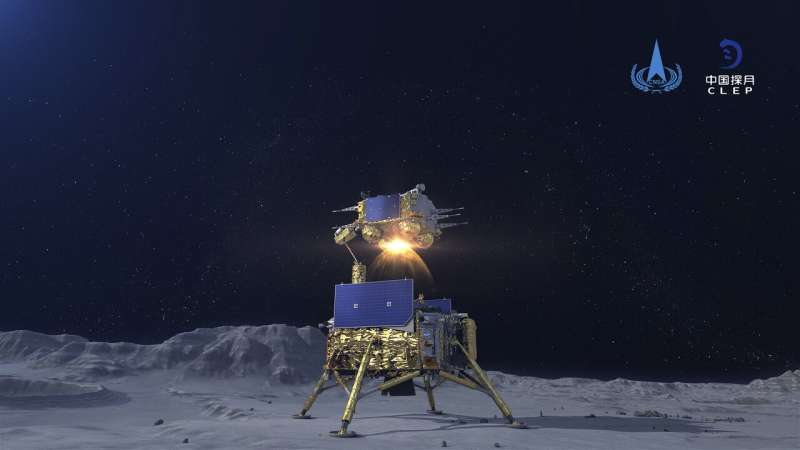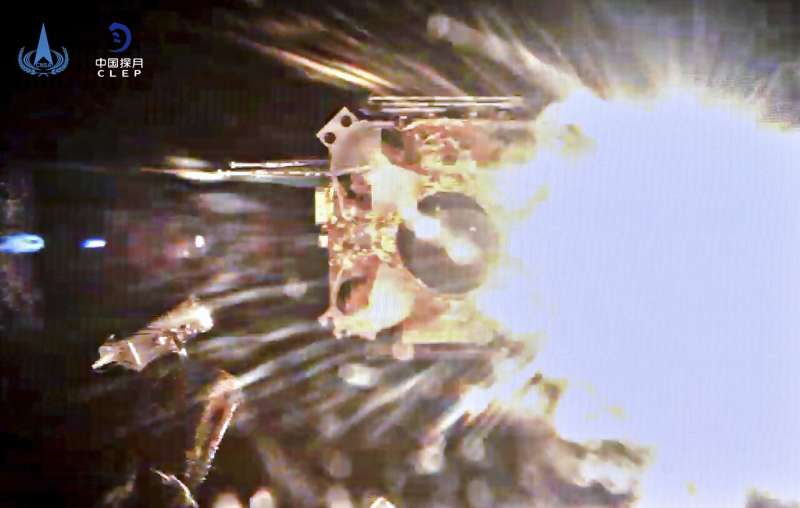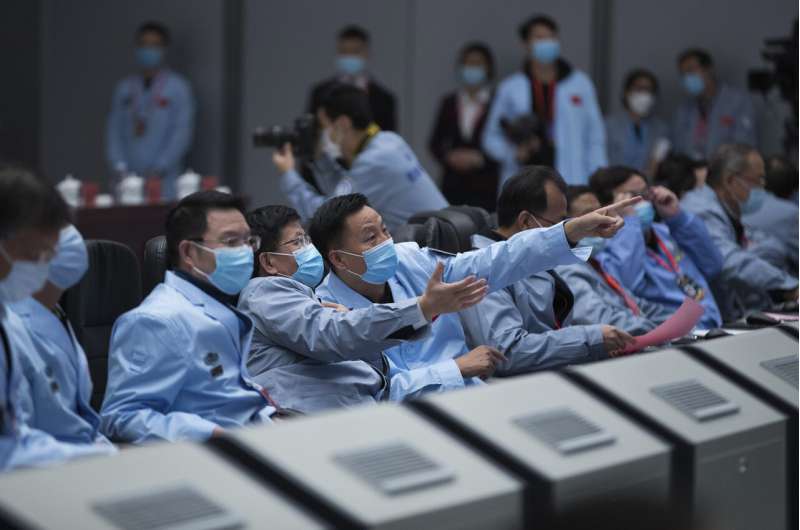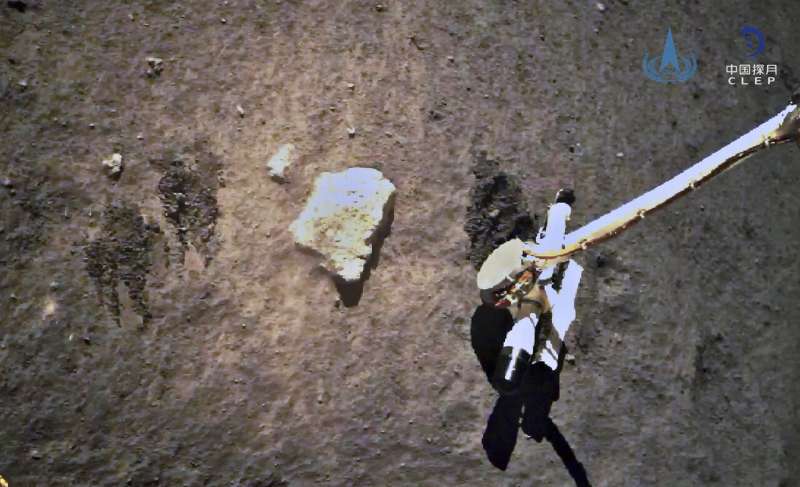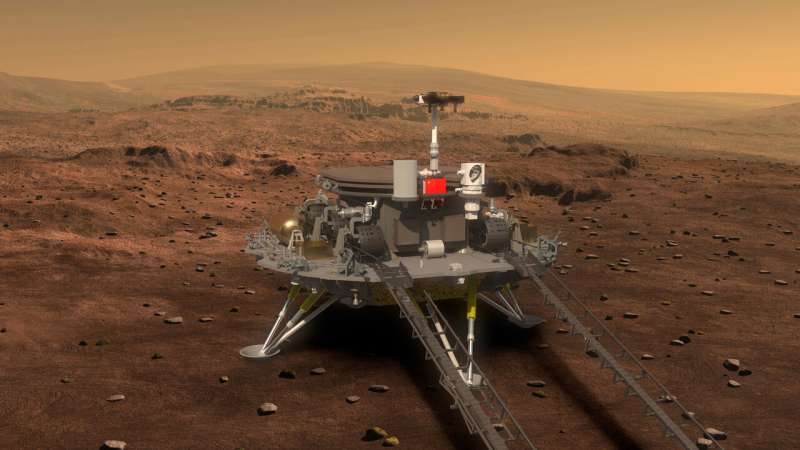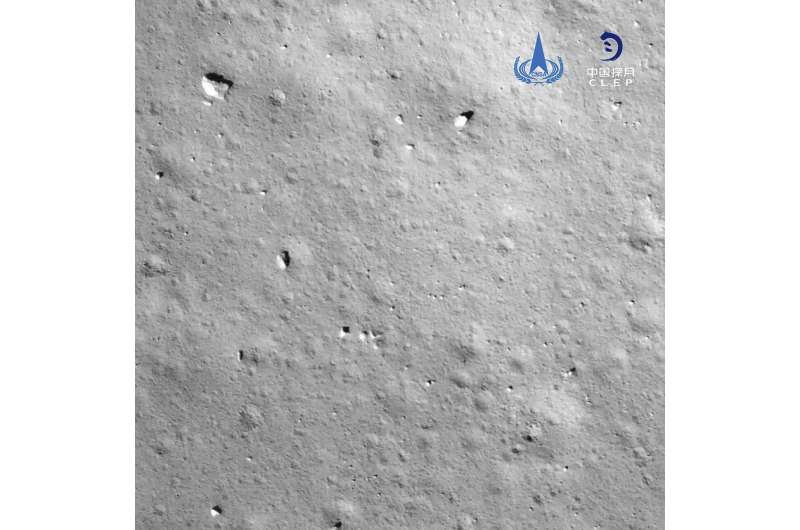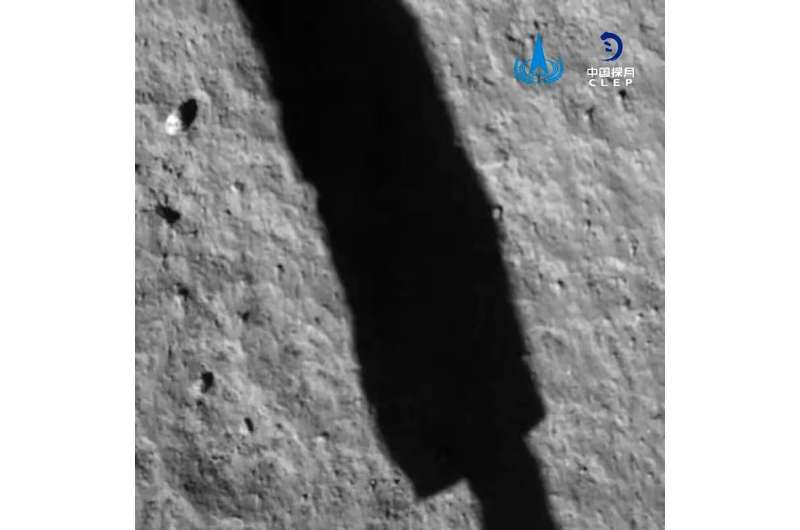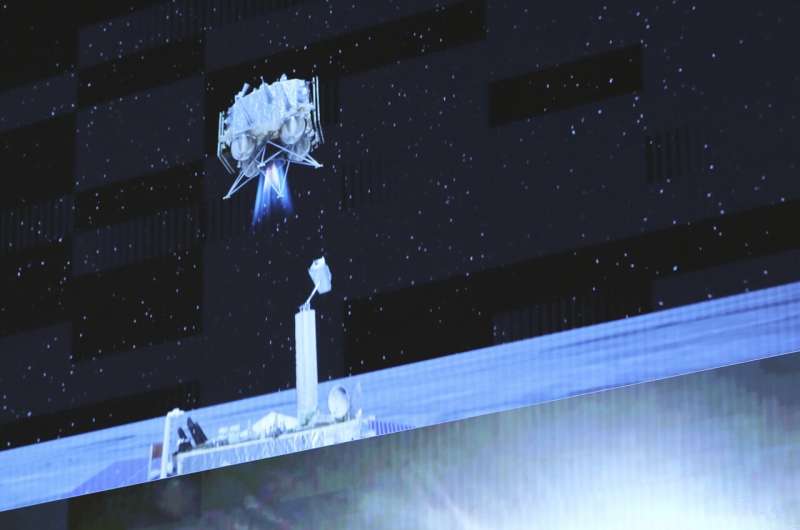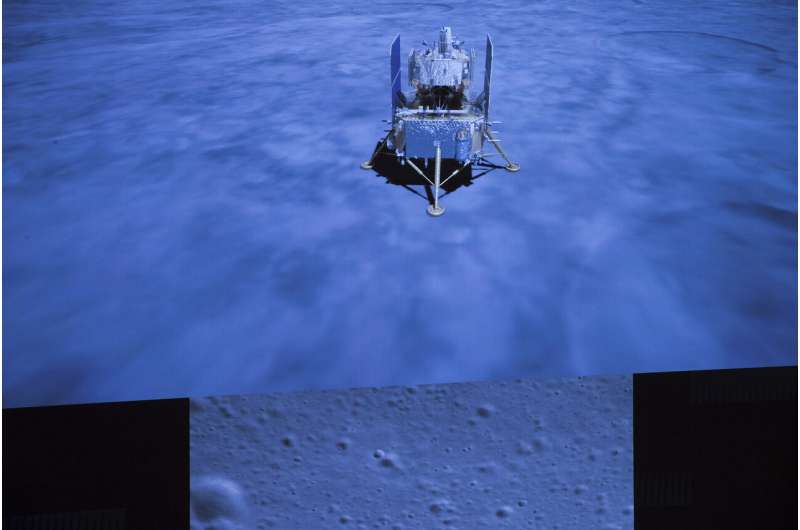In this China National Space Administration (CNSA) photo released by Xinhua News Agency, a simulated image of the ascender of Chang'e-5 spacecraft blasting off from the lunar surface at the Beijing Aerospace Control Center (BACC) in Beijing on Dec. 3, 2020. The Chinese lunar probe lifted off from the moon Thursday night with a cargo of lunar samples on the first stage of its return to Earth, state media reported. (China National Space Administration/Xinhua via AP)
A Chinese spacecraft lifted off from the moon Thursday night with a load of lunar rocks, the first stage of its return to Earth, the government space agency reported.
Chang'e 5, the third Chinese spacecraft to land on the moon and the first to take off from it again, is the latest in a series of increasingly ambitious missions for Beijing's space program, which also has a orbiter and rover headed to Mars.
The Chang'e 5 touched down Tuesday on the Sea of Storms on the moon's near side. Its mission: collect about 2 kilograms (4 pounds) of lunar rocks and bring them back to Earth, the first return of samples since Soviet spacecraft did so in the 1970s. Earlier, the U.S. Apollo astronauts brought back hundreds of pounds of moon rocks.
The landing site is near a formation called the Mons Rumker and may contain rocks billions of years younger than those retrieved earlier.
The ascent vehicle lifted off from the moon shortly after 11 p.m. Beijing time Thursday (1500 GMT) and was due to rendezvous with a return vehicle in lunar orbit, then transfer the samples to a capsule, according to the China National Space Administration. The moon rocks and debris were sealed inside a special canister to avoid contamination.
This image provided by China National Space Administration shows the ascender of Chang'e-5 spacecraft blasting off from the moon surface on Thursday, Dec. 3, 2020. A Chinese lunar probe lifted off from the moon on Thursday night with a cargo of lunar samples on the first stage of its return to Earth, the government space agency reported, on what is expected to be a breakthrough mission for the rising Asian space power. (China National Space Administration/Xinhua via AP)
It wasn't clear when the linkup would occur. After the transfer, the ascent module would be ejected and the capsule would remain in lunar orbit for about a week, awaiting the optimal time to make the trip back to Earth.
Chinese officials have said the capsule with the samples is due to land on Earth around the middle of the month. Touchdown is planned for the grasslands of Inner Mongolia, where China's astronauts have made their return in Shenzhou spacecraft.
Chang'e 5's lander, which remained on the moon, was capable of scooping samples from the surface and drilling 2 meters (about 6 feet).
While retrieving samples was its main task, the lander also was equipped to extensively photograph the area, map conditions below the surface with ground penetrating radar and analyze the lunar soil for minerals and water content.
-
This image taken by panoramic camera aboard the lander-ascender combination of Chang'e-5 spacecraft provided by China National Space Administration shows a moon surface after it landed on the moon on Wednesday, Dec. 2, 2020. Chinese government say the spacecraft landed on the moon on Tuesday to bring back lunar rocks to Earth for the first time since the 1970s. (China National Space Administration/Xinhua via AP)
-
This image provided by China National Space Administration shows Chang'e-5 probe gathering samples on the moon surface on Wednesday, Dec. 2, 2020. A Chinese lunar probe lifted off from the moon Thursday, Dec. 3 night with a cargo of lunar samples on the first stage of its return to Earth, the government space agency reported, on what is expected to be a breakthrough mission for the rising Asian space power. (China National Space Administration/Xinhua via AP)
-
This artist's rendering provided to China's Xinhua News Agency on Aug. 23, 2016, by the lunar probe and space project center of Chinese State Administration of Science, Technology and Industry for National Defense, shows a concept design for the Chinese Mars 2020 rover and lander. China's landing of its third probe on the moon is part of an increasingly ambitious space program that has a robot rover en route to Mars, is developing a reusable space plane and plans to put humans back on the lunar surface. (Chinese State Administration of Science, Technology, and Industry for National Defense via Xinhua via AP, File)
-
This image taken by camera aboard Chang'e-5 spacecraft provided by China National Space Administration shows a moon surface during its landing process Tuesday, Dec. 1, 2020. The Chinese spacecraft landed on the moon Tuesday to bring back lunar rocks to Earth for the first time since the 1970s, the government announced. (China National Space Administration via AP)
-
In this Dec. 8, 2018, file photo released by Xinhua News Agency, the Chang'e 4 lunar probe launches from the the Xichang Satellite Launch Center in southwest China's Sichuan Province. China's landing of its third probe on the moon is part of an increasingly ambitious space program that has a robot rover en route to Mars, is developing a reusable space plane and plans to put humans back on the lunar surface. (Jiang Hongjing/Xinhua via AP, File)
-
In this image taken by camera aboard Chang'e 5 spacecraft provided by China National Space Administration, its shadow is reflected on the surface of the moon during its landing process on Tuesday, Dec. 1, 2020. The Chinese spacecraft landed on the moon Tuesday to bring back lunar rocks to Earth for the first time since the 1970s, the government announced. (China National Space Administration via AP)
-
In this photo released by Xinhua News Agency, screens at the Beijing Aerospace Control Center (BACC) show the blast and the simulation of the ascender of Chang'e-5 spacecraft blasting off from the lunar surface in Beijing on Thursday Dec. 3, 2020 The Chinese lunar probe lifted off from the moon Thursday night with a cargo of lunar samples on the first stage of its return to Earth, state media reported. (Jin Liwang/Xinhua via AP)
-
In this photo released by Xinhua News Agency, a screen shows the landed Chang'e-5 spacecraft and a moon surface picture, below, taken by camera aboard Chang'e-5 spacecraft during its landing process, at Beijing Aerospace Control Center (BACC) in Beijing on Tuesday, Dec. 1, 2020. A Chinese spacecraft landed on the moon Tuesday to bring back lunar rocks to Earth for the first time since the 1970s, the government announced. (Jin Liwang/Xinhua via AP)
Right before the ascent vehicle lifted off, the lander unfurled what the space administration called the first free-standing Chinese flag on the moon. The agency posted an image—apparently taken from the lander—of the ascend vehicle firing its engines as it took off.
Chang'e 5 has revived talk of China one day sending astronauts to the moon and possibly building a scientific base there, although no timeline has been proposed for such projects.
China launched its first temporary orbiting laboratory in 2011 and a second in 2016. Plans call for a permanent space station after 2022, possibly to be serviced by a reusable space plane.
While China is boosting cooperation with the European Space Agency and others, interactions with NASA are severely limited by U.S. concerns over the secretive nature and close military links of the Chinese program.
© 2020 The Associated Press. All rights reserved. This material may not be published, broadcast, rewritten or redistributed without permission.
